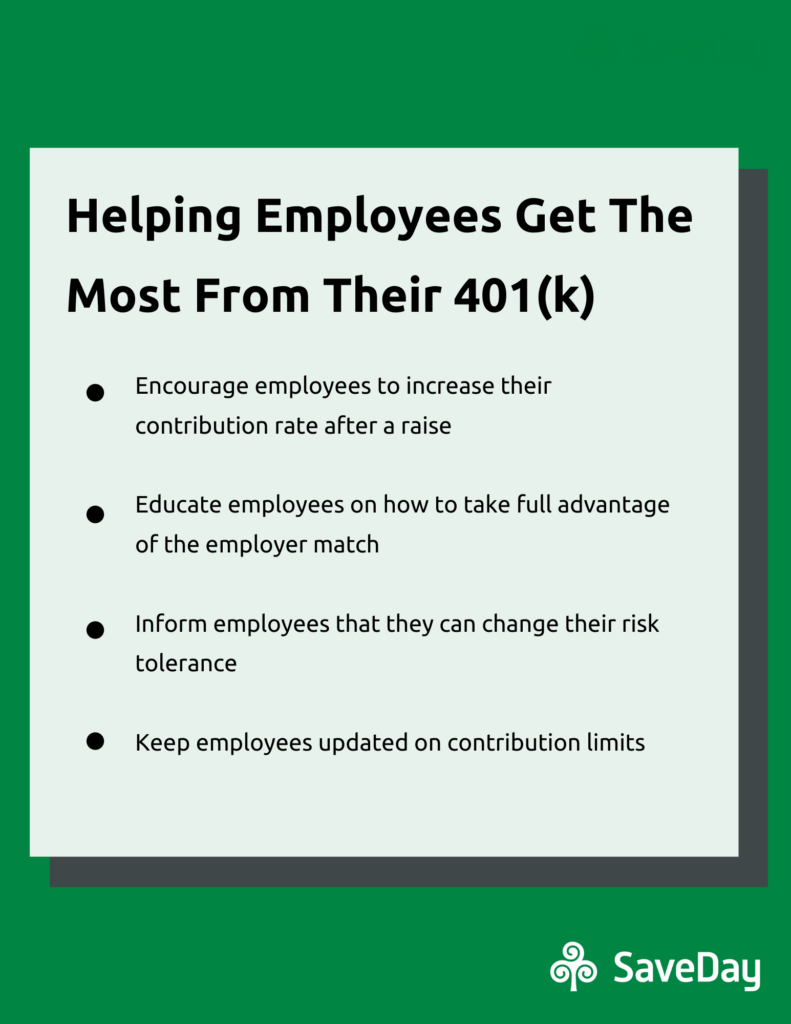When it comes to interacting with their 401(k), a Charles Schwab survey found that 59% of individuals haven’t taken any action with theirs. This doesn’t come as much of a surprise considering many people will open a 401(k) and then won’t touch it again until they near retirement.
Employees with this “set-it and forget-it” mindset end up losing out on extra money, whether it’s from not taking full advantage of an employer match, or forgetting to increase their contribution rate after a big raise.
Either way, as an employer, you have an ethical obligation to help your employees succeed in saving for retirement.
While there’s no set formula for retirement saving success, this checklist will assist you in helping your employees get the most from their 401(k).

Encourage employees to increase their contribution rate after a raise
Getting a raise at work is always an exciting moment, and the last thing on the minds of your employees when this happens is putting more money into their 401(k).
Upon receiving a pay raise, give your employee a gentle suggestion to increase their 401(k) contribution rate, and explain how doing so will benefit them.
Educate employees on how to take full advantage of the employer match
Many employees don’t take full advantage of this incentive, and in turn, lose out on a lot of extra money. Educate your employees on how employer matching is set up at your company, and inform them that to make the most of the match, their contribution rate must be the same as the employer match.
This may feel counterintuitive as the employer, but matching employee 401(k) contributions could qualify as an ordinary business expense and end up being tax-deductible. Check with your tax professional about tax deductions.
Inform employees that they can change their risk tolerance
An individual’s risk tolerance changes over time, particularly as they begin approaching retirement. Whether they forgot they could change it or simply weren’t aware that it could be changed, your employees will be grateful for the reminder.
Changing risk tolerance often is not recommended, and should only be done in special cases, such as a major life change or a significant increase (or decrease) in income.
Keep employees updated on contribution limits
Contribution limits for 401(k) accounts usually change from year to year, typically increasingly from the previous year. It’s always a good idea to remind your employees of these changes, that way they can make the most of their contributions.
Don’t forget to include a reminder that once individuals reach age 50, they are eligible to make catch-up contributions.
The smallest change can have the biggest impact, and saving for retirement is no exception. Helping your employees make changes like these is easy with Saveday, and can all be done directly on your dashboard. Contact us if you’re unsure of how to make any of these changes, and we’ll be happy to help.
Photo by cottonbro from Pexels.
*This material has been prepared for informational purposes only, and is not intended to provide, and should not be relied on for tax, legal, or accounting advice. Saveday makes no warranties with regard to such information or results obtained by its use and disclaims any liability arising out of your use of, or any tax position taken in reliance on, such information. Consult an attorney or tax professional regarding your specific situation and before engaging in any transactions. The information may not reflect the most current legal developments and is not guaranteed to be complete, correct, or up-to-date.






